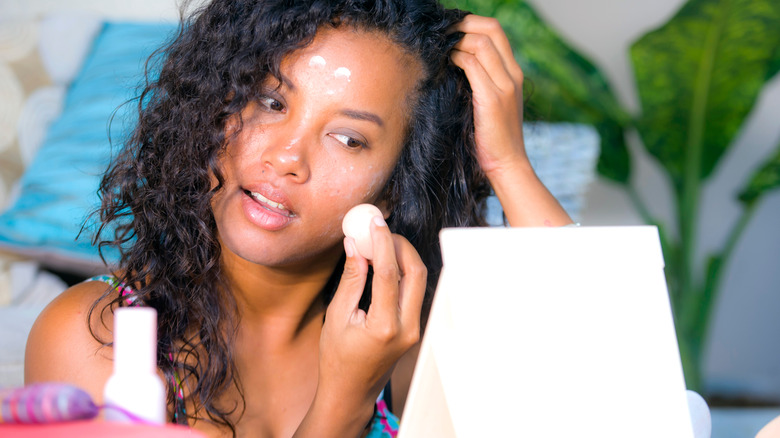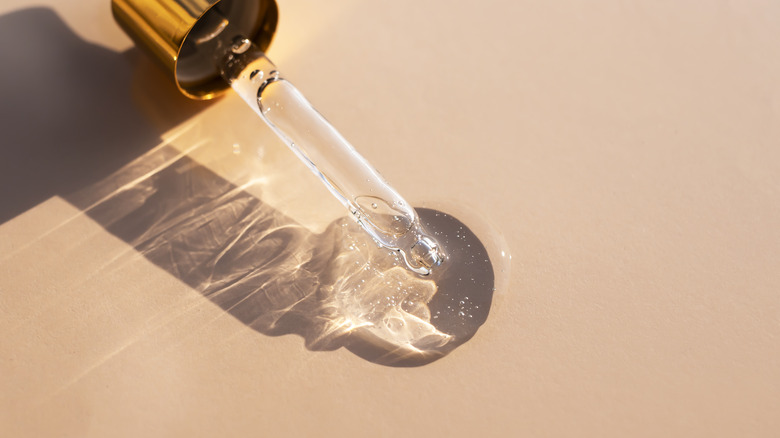Why You Need A Primer With Hyaluronic Acid If You Have Dry Skin
Your skin is uncomfortably dry and flaky no matter how much you moisturize, and the moment even a drop of foundation touches it, all those wrinkles and fine lines glare at you in the mirror even more. As a result, getting your face to look Instagram-ready is a major struggle, but you know that primer can be helpful in giving your foundation a clean slate to work on.
Bring back some plumpness by adding a hydrating hyaluronic acid primer to your makeup bag. Hyaluronic acid is something youthful skin already has, but you start to lose it as you age, leading to issues with dryness. Adding hyaluronic acid back in makes your face look radiant once again by quenching your thirsty pores and giving you that plump look you're used to.
Enjoy the key benefits that primers with hyaluronic acid can bring to your face while finding out from the experts several ways that you can combat dry skin through your skincare regime in general, too.
How hyaluronic acid helps dry skin
As you age, you're already contending with skin issues like wrinkles, discoloration, and other changes. However, when you add dry skin into the mix, it makes makeup application nearly impossible. Thankfully, hydrating primers with hyaluronic acid offer the moisture-locking technology your skin is begging for.
According to dermatologist Dr. Sam Bunting, "When it's applied topically, skin acts as a highly-effective barrier, and those hyaluronic acid molecules are too big to squeeze through the dermis, which is where it needs to be to help plump lines and wrinkles," (via Stylist). Therefore, when hyaluronic acid is added to a primer, it can help hydrate the face while creating a perfect palette for you to apply foundation and other makeup. In addition to plumping up your skin, it acts as a moisturizer to keep it supple because hyaluronic acid likes to find and attach to those water molecules.
But it's important to note that you should never apply a primer with hyaluronic acid to dehydrated skin. When the skin is dehydrated, the hyaluronic acid can actually pull the water from much deeper down in your skin, making it feel even tighter, which can make your makeup settle in lines and imperfections. So, ensure you're starting with a moist face by applying moisturizer or serums first. In addition to adding a hyaluronic acid primer to your skincare routine, there are a few other tips you can try to keep your skin moist.
Tips for improving dry skin
Adding a hyaluronic acid primer to your makeup routine is one way to help deal with naturally occurring dry skin or issues brought on by a lack of humidity in the air. However, it's not the only way to take up arms against thirsty skin. According to the American Academy of Dermatology Association (AAD), baths, cleansers, and air quality can all contribute to your skin feeling dry, flaky, and tight.
Although it might seem strange, long baths and hot showers could actually be sucking out moisture, so the AAD recommends using warm water and limiting showers to no more than 10 minutes. It's also extremely beneficial to apply moisturizer to your skin immediately after showering or washing your face with gentle exfoliation using a hydrating cleanser. Additionally, sleeping with a humidifier at night bathes your skin in much-needed moisture while you are snugly tucked into bed.
Keep in mind that dry skin happens to everyone; you might just be naturally prone to it, or maybe dry skin occurs simply due to the dry air around you. No matter the case, applying a hyaluronic acid primer can help to give your skin a supple boost and provide you with a plump and hydrated palette for applying your foundation. Just be sure to use a moisturizer or serum too, so the hyaluronic acid doesn't make the issue worse rather than better.


